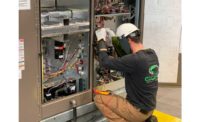Johnston County operates 32 air conditioned schools and additional administrative buildings. It is one of the fastest-growing school districts in the state, with an enrollment of 23,000, and adding over 1,000 students each year. Because of this growth, Gilbert looked for standardized energy solutions that could be applied in multiple buildings to save money on maintenance supplies and spare parts. As at most districts, holding down operating and energy costs is a priority.
But as the pace of school construction was accelerating, the need for improved classroom comfort was emphasized. The district's energy team and its construction department worked with Trane to standardize a school design featuring air cooled screw chillers and ice storage tanks as an optimum solution for school cooling.
Standard Chiller Package
The district's typical elementary school encompasses 82,000 sq ft and is equipped with two 90-ton Trane air cooled Series R(tm) screw chillers and six Calmac Icebank(tm) ice storage tanks. Middle schools of 111,000 sq ft typically have two 125-ton chillers and nine ice tanks. The new high school is 260,000 sq ft and has three Trane air cooled chillers and 12 Calmac tanks.Gilbert said the air cooled chiller with ice storage makes good sense. "We like the Trane Series R air cooled chillers because of their reliability, and that we don't have to deal with condenser water. No water treatment or tower maintenance is needed, so this approach also eliminates water and sewer charges. Unattended operation is also more practical."
The primary advantage of ice storage is that it reduces electric demand charges, and allows the schools to qualify for a favorable time-of-use electric energy rate from its electric supplier. The chillers operate on a primary loop, with a 25% glycol solution at 24?F going to the ice storage tanks.
Normally, the schools make ice during the nighttime hours. In the morning, the chillers are used directly - through a Polaris heat exchanger - from 7 a.m. until 9 or 9:30 a.m., when the system is switched over to use the stored ice, which normally lasts through the day.
Chilled water from the secondary loop is circulated to AHUs and fancoils throughout the building. The system's Trane Modular Climate Changer(tm) AHUs are located on mechanical platforms in the buildings for distribution of air to the larger spaces such as hallways, gyms, and the cafeteria. These AHUs are directly ducted to ceiling diffusers in these large areas.
Classrooms are served by individual AHUs that have thumb-wheel classroom controls. The classrooms are given a range from 68 degrees to 76 degrees. The AHUs typically receive chilled water at temperatures ranging from 46 degrees down to 41 degrees, depending on outdoor temperatures. For space heating and for air tempering purposes, the AHUs receive hot water from a gas-fired boiler. All of the AHUs are on a four-pipe system.
Gilbert noted that with the tight construction in newer school buildings, ventilation and humidity management are increasingly important. Most schools use humidistats, which are set to initiate air handler operation in a dehumidifying mode when rh levels exceed 60%.
Economic Benefits
Gilbert said the economic benefits of ice storage are impressive. "We have found simple project paybacks of as little as two years. Over the anticipated life of the school of 40 years or more, we believe the total savings could be as great as $1.2 million in a typical middle school."Gilbert points out that the largest portion of the savings comes from reduced electric energy and demand charges. "Another element is that the chiller size can be smaller than if you had no storage, which partially offsets the cost of the ice storage system."
With an average of two new schools being built every year, the scale of ice storage increases every year. The school system today has met one of its top energy goals, and has demonstrated its commitment to keeping classrooms occupied every day of the school year.ES








